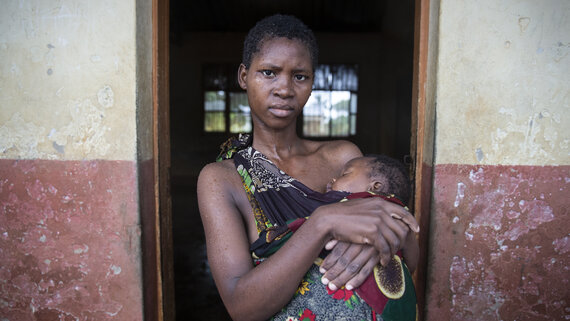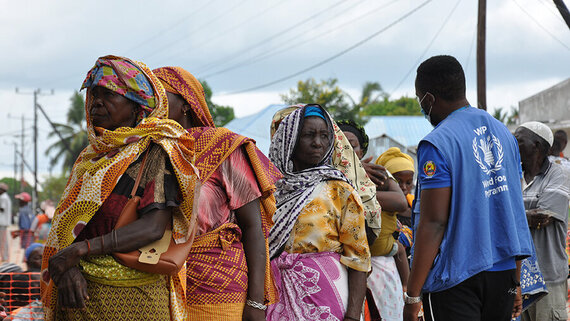Analysis of the context, crisis and needs
The conflict in northern Mozambique’s Cabo Delgado Province, which began in October 2017, continued to escalate in the first half of 2021, before intervention by foreign forces from July. The attack by non-State armed groups (NSAGs) and clashes with security in Palma District, which began in late March, forced more than 100,000 people to flee the zone by foot, boat and road to reach safer destinations. The intervention of foreign forces from Rwanda and the Southern African Development Community led to a lull in large-scale attacks. However, confrontations between NSAGs and security forces—particularly in Mocimboa da Praia, Nangade and Palma districts—displaced thousands of people, with over 6,000 people fleeing each week during operations by Mozambican and foreign forces to recapture Mocimboa da Praia in the first three weeks of August. Although there were reports of small numbers of people returning to areas recaptured by the Government and allied foreign forces in the latter half of the year, this information was difficult to verify.
Throughout 2021, the crisis in Cabo Delgado deepened the needs of displaced people — many of whom have been forced to flee multiple times — and host communities, who have continued to show incredible solidarity in the face of increasingly stretched resources and services. According to IOM’s Displacement Tracking Matrix Baseline Assessment Round 13, an estimated 745,000 people were internally displaced in northern Mozambique by September 2021, including 642,404 people in Cabo Delgado, 99,448 in Nampula and 1,221 in Niassa. Children and women accounted for 52 per cent and 27 per cent of displaced people, respectively, and there were nearly 10,800 elderly people, more than 3,800 unaccompanied children, over 3,400 pregnant women and more than 800 people with disabilities among those displaced. Around 80 per cent of displaced people were staying with family and friends in host communities, whose already meagre resources were strained tremendously by the growing influxes. Pemba City, for example, now hosts more than 152,000 displaced people on top of its original population of around 224,000 people, putting the city’s health and education services under immense pressure. In Metuge district, the number of displaced people (127,646) is higher than the original population (101,339).

Pemba, Mozambique
This mother lost everything when Cyclone Kenneth made landfall in Cabo Delgado Province. Floods and heavy rains in northern Mozambique are exacerbating the hardship of people living there - just one year after Hurricanes Kenneth and Idai devastated the region. Violence by armed groups is also on the rise, leading to high numbers of people being displaced. In many East African countries, such as Mozambique, armed conflicts, droughts, floods and plagues of locusts are threatening the livelihoods of many families.
UNICEF/De WetProtection risks remained a grave concern, especially for women and girls, people with disabilities, older persons and people living with HIV/AIDS, with reports of horrific violence against civilians by NSAGs, including killings, beheadings and kidnappings, as well as allegations of violations by Government forces. Civilians attempting to leave Palma faced challenges and were unable to access international protection. The journey was perilous and expensive, with many people walking for days through the bush to reach safer areas. At the same time, people attempting to seek asylum in Tanzania were refouled to Mozambique, with nearly 10,400 Mozambicans forcibly returned from Tanzania to Mozambique between January and September 2021, according to UNHCR. People impacted by the conflict were exposed to gender-based violence and child abuse, and they are more likely to resort to negative coping mechanisms, including transactional sex, and be exposed to exploitation.
The armed conflict has heightened food insecurity and malnutrition, with families forced to abandon their homes and fields, and erratic rainfall in some parts of the region has compounded crop losses, according to the latest IPC analysis. In the three northern provinces — Cabo Delgado, Nampula and Niassa — more than 900,000 people are severely food insecure. In seven southern districts of Cabo Delgado, more than 228,000 people who are either displaced (128,000) or hosting displaced people (101,000) in their households were projected to face severe food insecurity (IPC Phase 3 or above) between April and September 2021. The analysis covered internally displaced people (IDPs) in five districts (Ancuabe, Balama, Chiúre, Metuge and Namuno) and households hosting IDPs in seven districts (Ancuabe, Balama, Chiúre, Metuge, Montepuez, Namuno and Pemba City) and highlighted the severe toll the crisis has taken on host communities.
The escalating violence significantly impacted essential services across Cabo Delgado. For example, in Mocimboa da Praia, widespread destruction of infrastructure — including the airport, hospital, as well as schools, and water and electrical systems — was reported in areas retaken by security forces in August. In other parts of the province, including Macomia, Muidumbe, Nangade, Palma and Quissanga, the delivery of essential services — especially health care and education — was hampered by the absence of key personnel and the destruction of or damage to facilities and equipment. Nearly half of Cabo Delgado’s health centres (43 out of 88) were forcibly closed due to insecurity. In the areas hardest hit by conflict, people were without electricity and telecommunications for most of the year. After 13 months of general blackout, electricity was re-established in Mueda in September 2021, following Muidumbe, Palma, Nangade and Mocimboa da Praia. Partial phone and internet connectivity re-established between Palma and Mocimboa da Praia.
Projected situation in 2022 and beyond
At least 1.5 million people will need life-saving and life-sustaining humanitarian assistance and protection in northern Mozambique in 2022 due to the continued impact of armed conflict, violence and insecurity in Cabo Delgado Province. This includes the 745,000 conflict-displaced people, as well as people in host communities whose coping capacities have been exhausted after three years of opening their homes to those fleeing the violence. While the Government works to combat non-state armed groups and restore peace in Cabo Delgado—with support from the international community and allied forces—some returns of people to areas recaptured are anticipated in 2022. The situation, however, remains volatile and attacks by NSAGs as well as allegations of violations against civilian by security forces continue to be reported. In addition, the conflict and repeated displacement have destroyed livelihoods, disrupted markets, and essential services across the hardest-hit districts, particularly affecting access to education and health services in a region facing endemic disease outbreaks. Therefore, the Protection Cluster continues to emphasize the importance of returns taking place only when security conditions are met and services are restored in line with accepted standards.

Beira, Mozambique
Escalating violence in northern Mozambique is pushing hundreds of thousands of people into food insecurity. "They sit in cramped areas with no shelter, no sanitation, struggling to process the trauma of horrors they’ve experienced," said WFP’s Regional Director for Southern Africa. Climatic shocks, which disrupted agriculture, fisheries and livelihoods, are compounding problems: only limited supplies are reaching markets, which means the cost of food and household items is rising fast.
WFP/Sean RajmanHumanitarian needs are concentrated in the districts hardest hit by the conflict — Macomia, Mocimboa da Praia, Palma and Quissanga — as well as those that host the highest number of displaced people, namely Nangade, Metuge, Montepuez, Mueda and Pemba. The unique needs of women and girls are a high priority, with 53 per cent of people in need being female and women-headed households — who constitute one third of families in the three northern provinces — who are faced with specific challenges. The crisis has severely impacted children, with some 59 per cent of people across Cabo Delgado, Nampula and Niassa being under 19 years old, according to the census. While only 3 per cent of people in Cabo Delgado, Nampula and Niassa are over 65 years old, they face multiple unique challenges, including difficulties fleeing conflict as well as constraints on physical access to services. Ensuring access to vital services and holistic support for the estimated 468,000 people (most of whom are women) living with HIV in Cabo Delgado, Nampula and Niassa is critical.
Response priorities in 2022
Humanitarian organizations significantly scaled up their response in northern Mozambique in 2021, enabling partners to provide life-saving and life-sustaining assistance and protection to 1.23 million people; more than double the number of people reached in 2020 (515,000). More than 957,300 people—52 per cent of them women—received regular food assistance, although underfunding has forced humanitarians to distribute half rations since August. By the end of August, more than 850 aid workers—more than 730 of them Mozambican— were delivering assistance and protection across Cabo Delgado Province (up from just over 300 in October 2020), and by the end of September at least 66 humanitarian organizations were responding (up from 47 in January 2021), of which 58 per cent (38) were international non-governmental organizations (INGOs), 30 per cent (20) national NGOs and 12 per cent (8) UN entities.
A key focus in 2021 was expanding the scale and scope of humanitarian operations in hard-to-reach and partially accessible areas. This was done through a combination of inter-agency rapid assessment and response missions, as well as establishing district-level coordination and response, leveraging the capacity of partners based in the districts in Ancuabe, Balama, Chiure, Ibo, Macomia, Mueda and Namuno. However, humanitarian movements remained constrained in some areas due to insecurity and administrative obstacles. People’s access to essential services—especially health and education—remained inadequate in many parts of Cabo Delgado due destruction, damage and absence of personnel.
Mozambique HRP
In 2022, the humanitarian response in northern Mozambique will target 1.2 million people in the most urgent need of assistance and protection in Cabo Delgado, Nampula and Niassa. The geographic focus of the response is aligned with the severity of the needs identified, with an emphasis on districts that host the highest numbers of displaced people and districts hardest hit by the conflict.
Humanitarian actors will coordinate closely with development actors, who will be working to rebuild infrastructure and re-establish essential services impacted by the conflict in 2022. It will include identifying complementarities with the activities promoted by the Government’s Agency for Integrated Development of the North (ADIN). The Agency, with support from the international community, is working with the UN, local authorities, non-governmental organizations, and other local stakeholders to build or rehabilitate public and private services, such as public administration buildings, health and education facilities, access roads, energy and telecommunication systems, water supplies, markets and shops.
Further reading
Source: OCHA
Source: Humanitarian Insight
Source: Financial Tracking Service



